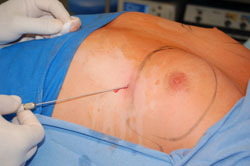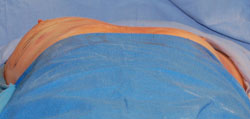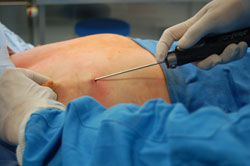
Soaking the operated area with right fluid significantly reduces intra-operative bleeding
In recent years an increase in the occurrence of male breast hypertrophy called gynecomastia has been observed. It may manifest itself in three forms: adipose, glandular and mixed. The most efficient method of treating adipose gynecomastia is by liposuction. If there is a glandular component present (mixed or glandular gynecomastia) it is necessary to excise glandular tissue, with the resulting scarring of the areola. The latest method of surgical treatment of glandular gynecomastia permits excision of the entire lesion through a small incision in the submammary area. The small size of the incision (approx. 3 mm) and its location make the scar undetectable.
Indications

Suction of adipose tissue with a thin cannule
The most common form of gynecomastia is its mixed form. It is not always possible to precisely diagnose what proportion of the lesion the mammary gland is. Therefore each individual case of gynecomastia is a potential indication for no-scar treatment with the shave method. Also repeat procedures following an earlier breast liposuction can be performed using this method. However, corrections of poorly performed gynecomastia excisions usually require a more individualized approach and involve surgical incision within the areola.
Procedure

Suction of adipose tissue with a thin cannule
Corrective gynecomastia is performed under general anesthesia. Typically the first step of the procedure is suction of breast adipose tissue. It is carried out using tumescence method (wet), which significantly reduces intra-operative bleeding (Photo 1). A micro cannule to remove adipose tissue is inserted through a small incision of about 3 mm in the sub-mammary area (Photo 2). Following the liposuction the surgeon decides whether it is necessary to remove glandular tissue (Photo 3). If so, then a device (shaver) is inserted through the same incision to excise glandular tissue (Photo 4). Usually a thin layer of glandular tissue is left directly under the areola to ensure a natural and esthetic cosmetic effect in the area. In some cases it is possible to examine microscopically the excised tissues. Then the small sub-mammary incision is closed with steri-strips. Occasionally a single suture may be applied. Also occasionally a thin bulb drain is left in the operated area. In some cases (e.g. with heavy bleeding)it may be necessary to expand the procedure by incising the areola. Postoperatively the patient is fitted with a compression vest on the chest.
Postoperatively

Glandular tissue is being removed with the shaver
Patients remain in the clinic one day following the procedure. Usually they are able to get up and about in the evening. If a bulb drain has been applied, it is removed within 24 hours postoperatively. Edema in the operated area and localized bruises may subsist for up to a month post-op. Also a compression vest is recommended for a month although it may be removed for baths. If the wound has been closed with steri-strips then patients do not need to come for follow-up after one week. One week is also the length of time after which sporting activities may be undertaken. The final effect is usually achieved three months after the procedure. After that period it is recommended to report to the clinic for treatment evaluation.
Advantages of the shave method
- Precise removal of male breast hypertrophy – gynecomastia
- The entire procedure is performed via a small incision in the sub-mammary area, leaving an undetectable scar
- It is possible to microscopically examine the excised glands
- Short convalescence period
- No need for follow-up visits immediately after procedure
Disadvantages of the shave method
- A small risk of bleeding in the operated area necessitating the use of bulb drains
- In some cases it may be necessary to expand the procedure with incision in the areola area.